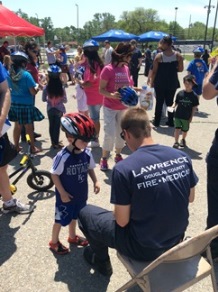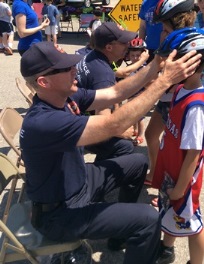
Bicycling continues to be a very popular activity for children and adults. Additionally, inline skating, skateboarding and scootering continue to grow in popularity. While all these activities provide a great form of exercise, wheeled sports are associated with more childhood injuries than any other consumer product except the automobile.
Did you know?
- City of Lawrence Ordinance No. 7738 states; "No person fifteen (15) years of age or younger shall ride a bicycle, wear, ride or use any roller skates, inline skates, roller blades, skateboards, or scooter, as these things are commonly defined, within the city limits without properly wearing an approved skate or bicycle helmet securely fastened by chin or neck strap."
- According to Safe Kids Worldwide:
- Child bicycle deaths increase by 45% above the monthly average in the summer months?
- Every two minutes, a child is treated in an emergency room for an unintentional cycle-related incident.
- More children ages 5 to 14 are seen in emergency rooms for biking related-injuries than any other sport.
- Helmet use is the most effective way to reduce bicycle-related fatalities.
- Just by wearing a helmet, you can reduce the risk of severe brain injury by 88%, yet 45% of children 14 and under usually wear a helmet.
Helmet Safety

- Find the right helmet –
- Make sure your child has the right size helmet and wears it every time when riding, skating or scooting. Your children’s helmet should meet the U.S. Consumer Product Safety Commission’s standards.
- A helmet should sit on top of the head in a level position, and should not rock forward, backward or side to side. The helmet straps must always be buckled, but not too tightly.
- Position the helmet on your head. Look up and you should see the bottom rim of the helmet. The rim should be one to two finger-widths above the eyebrows.
- Make sure the straps of the helmet form a “V” under your ears when buckled. The strap should be snug but comfortable.
- Open your mouth as wide as you can. Do you feel the helmet hug your head? If not, tighten those straps and make sure the buckle is flat against your skin.
- Watch Lawrence-Douglas County Fire Medical Department's video: Bike Helmet Safety
- Wear appropriate helmets for the activity.
- Children should always wear a helmet for all wheeled sports activities.
- A properly-fitted bike helmet is just as effective when riding a scooter, roller skating or in-line skating.
- When skateboarding and long boarding, make sure your child wears a skateboarding helmet.
- You’d be surprised how much kids learn from watching you, so it’s extra important for parents to model proper behavior. Wear a helmet, even if you didn’t when you were a kid.
- Need a helmet?
- The department's Wheeled Sports Program provides free, high quality bicycle helmets to children under the age of 14. Each Spring, the department conducts the Lawrence Helmet Fair which provides information for all types of summer activities, along with free helmets. We provided nearly 700 helmets annually, through distribution at the annual helmet fair, parents bringing their children into one of our stations and various other programs.
For more information on our program: Wheeled Sports Program
- The department's Wheeled Sports Program provides free, high quality bicycle helmets to children under the age of 14. Each Spring, the department conducts the Lawrence Helmet Fair which provides information for all types of summer activities, along with free helmets. We provided nearly 700 helmets annually, through distribution at the annual helmet fair, parents bringing their children into one of our stations and various other programs.
Bike Safety
- Proper Equipment & Maintenance is Important
- Ensure proper bike fit by bringing the child along when shopping for a bike. Select one that is the right size for the child, not one he or she will grow into.
- When children are sitting on the seat of the bicycle, their feet should be able to touch the ground.
- Before the ride, make sure the reflectors are secure, brakes work properly, gears shift smoothly, and tires are tightly secured and properly inflated.
- Long or loose clothing can get caught in bike chains or wheel spokes. Dress young kids appropriately to ensure a safe ride.
- Teach and Watch
- Always model and teach safe behavior
- Actively supervise children until you're comfortable that they are responsible to ride on their own.
- Limit riding to sidewalks (although be careful for vehicles in driveways), parks or bike paths until age 10. No matter where you ride, teach your child to stay alert and watch for cars and trucks.
- Children should not ride when it's dark outside.
- Wear clothes and accessories that have reflective materials to make sure you are seen.
- Children should be able to demonstrate riding competence and knowledge of the rules of the road before cycling with traffic.
- Teach your kids to make eye contact with drivers. Bikers should make sure drivers are paying attention and are going to stop before they cross the street.
- Anticipate what drivers, pedestrians, and other people on bikes will do next. Watch for turning vehicles and ride outside the door zone of parked cars. Look out for debris, potholes, and other road hazards.
- Tell your kids to ride on the right side of the road, with traffic, not against it. Stay as far to the right as possible. Use appropriate hand signals and respect traffic signals, stopping at all stop signs and stoplights.

- Stop and look left, right and left again before entering a street or crossing an intersection. Look back and yield to traffic coming from behind before turning left.

Next: Skating and Skateboarding Safety Tips
*Sources: Safe Kids Worldwide (www.safekids.org) and Kids Health (www.kidshealth.org)*
